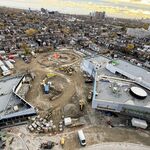I came back from Montreal on the evening of the 31st - thank you VIA, Union Station, and GO on a busy day. I had been thinking of the differences between Montreal and Toronto re pedestrians and cyclists once again, but i have posted on this topic before and had really nothing new to say. Then this morning I ran across this article by Andre Picard of the Globe and Mail. The article is about Paris, and cycling, and pedestrians, and taking back streets from car oriented transit, and to me, speaks to so much we discuss on these forums ( but which our faint of heart politicians are so reluctant to embrace). There was a similar article posted earlier on the University Ave thread discussing the planning process Paris is going through as it seeks to humanize the Champs Elysees. Reading this please also remember that the population of the city of Paris is 2.1 million , and the greater Paris region, a little over 12 million.
Andre’s article is paywalled currently, so with kudos to Andre Picard and the Globe….:
“In 2020, Rue de Rivoli, in the heart of Paris, was a six-lane street jammed with soul-sucking, horn-blasting traffic. Today, it has a single bus/taxi lane and expansive bike lanes crammed with riders, even on a cool winter’s day.
The street’s remake is symbolic of the transformation of Paris from a car city to a cycling city, a remarkable feat of political will as much as engineering.
In the early 1990s, the French capital had a laughable five kilometres of bike paths. Today, there are 4,017 kilometres of paths in the greater Paris area, with 2,158 more kilometres planned – all of it with concrete dividers and steel bollards, not just a splash of paint.
Most of that change has occurred in the past decade, though the embrace of bikes and e-bikes rose dramatically during a lengthy transit strike in 2019, and the COVID-19 pandemic that began in 2020.
More than one million of the greater Paris Region’s 12 million residents now cycle daily, and that’s only expected to increase as infrastructure improves.
Since the turn of the century, car trips have declined 60 per cent, public transit ridership is up 40 per cent, and car crashes down 30 per cent – all this according to the Atelier Parisien d’Urbanisme.
Anne Hidalgo, the Mayor of Paris since 2014, has been the catalyst for much of the change, elected on a promise to create “a Paris that breathes.” Promoting cycling is the cornerstone of a larger plan to fight climate change, reduce air pollution, and expand green space.
There have been countless initiatives to make the city more livable.
Paris has closed streets to traffic near elementary schools and daycares. So far, 168 streets have been transformed into play areas.
To discourage trips to the historical centre of the city, parking rates have been jacked up to €6 an hour. The speed limit has dropped to 30 kilometres an hour.
The bike-share program Vélib has 20,000 bicycles available at 1,400 stations. A quick, cheap rental is a great way for business people to make short trips to meetings, and a delightful way to be a tourist.
Paris has also created “low-emission zones,” where older, more polluting cars are banned. By 2030, there will be a total ban on gas-powered vehicles.
In most major cities, including Paris, cars – including roads and parking – occupy more than half of all public space. That’s an obscenity – a costly, inefficient one.
The pandemic reminded us that people need space to walk, to breathe, and to play. The redistribution of public space is long overdue.
While Ms. Hidalgo is often denounced as “anti-car,” she is actually pro-pedestrian, and pro-cyclist. Deadly heatwaves and a growing number of smog days fuelled the need for urgent change.
Paris is a city where millions of people live in cramped apartments, where the street is an extension of the home – it’s where children play, where merchants hawk their wares, where people eat and socialize.
But over the decades, streets have been commandeered by cars.
Is there anything more Parisian than strolling a grand boulevard? Well, now there is: Cycling that same boulevard.
Let’s not forget that Paris is a city with already tremendous public transit. The Métro, with daily ridership of more than four million people, features 16 lines and 308 stations, without counting the RER regional train service.
And it’s about to get better. The system is in the midst of a massive expansion, with four new lines and 68 new stations, most set to open before the 2024 Olympics. The Grand Paris Express will mostly facilitate travel from the suburbs to the city, but also connect suburbs to each other, which is almost unheard of in large metropolitan areas.
The suburbs, too, are greatly expanding their bike lanes and green spaces around these new transit hubs. Nationally, France has committed €2-billion to doubling its cycling infrastructure by 2030.
In Canadian cities, the cycling and public transit infrastructure is lamentable, with few exceptions.
We spend our time making excuses – the weather, the weather! But Toronto’s weather is not much different from that of Paris.
What’s lacking in Canada is political will – we need politicians and policy-makers to say we no longer accept the tyranny of the car. We need the recognition that, if we want to tackle climate change and make cities livable, the focus should be on improving the lots of cyclists and pedestrians.
To change people’s lives, we have to change the way they move.”
Loved that descriptor..........





